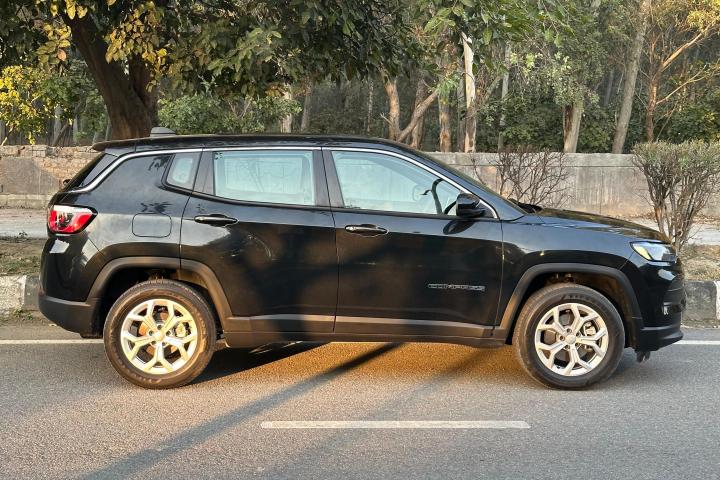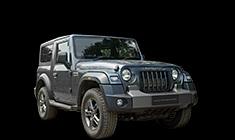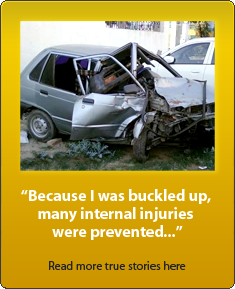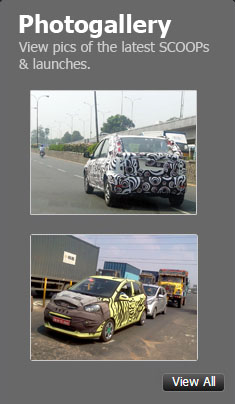News
Why I bought a manual Jeep Compass: Detailed review of the SUV
It is a great vehicle which helped me tackle my midlife crisis! But is it the best car in the Rs 20-30 lakh range?
BHPian Hispaniola recently shared this with other enthusiasts:
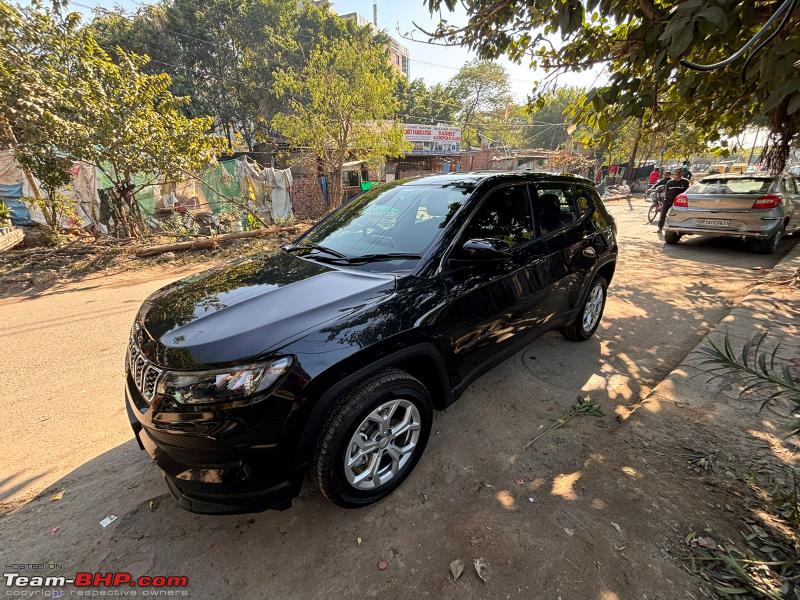
First things first, I was quite confused about choosing the title for this thread. Here are some of the options I considered over the past few weeks:
- Jeep Compass: Poor Man's BMW Experience
- Jeep Compass: Best Manual Car Below ₹1 Cr On Road in India
- Jeep Compass: Manual Should Be the Only Version to Buy
- Jeep Compass: The Car That Helped Me Choose a Career in India Rather Than Going Abroad
- Jeep Compass: My Wife's Choice
- Jeep Compass: Is Jeep Life Overhyped?
...and many more.
Give me a few minutes, and I’ll explain each of these in detail. For now, let’s quickly go through the pros and cons of the Jeep Compass.
What You’ll Like:
- It’s a looker. A black Compass is a sight to behold.
- Best interior quality in its segment.
- Powerful enough for most needs.
- Great handling—it feels connected to the road.
- Refined engine, except for the diesel clatter during cold starts.
What You Won’t Like:
- Expensive service costs (I can explain later why this might not be as serious as it seems).
- Small size—vehicles like the Mahindra XUV700 and Tata Harrier/Safari have better road presence.
- The base model offers terrific value for money, but higher automatic variants don’t.
Why the Jeep Compass?

My first experience with cars was with the Maruti 800—a peppy little machine with great manual controls and good enough performance up to 60 km/h, especially in the bottom end. When it was time to upgrade for my father, we bought a Honda Amaze Diesel Manual. A few years later, I drove a Grand i10 Manual in college before starting my job and later pursuing an MBA.
MBA Saga and How the Jeep Compass Launch Helped Me Stay Back in India
When the Compass was launched back in 2017, I had the option to either take the CAT and pursue an MBA in India or take the GMAT and move abroad. When I looked at Compass prices in the USA/Canada, I found them to be similarly priced in India.
Given the high insurance costs abroad, I did some funny math and concluded that if a car this good was available in India at a similar cost, there was no need to move abroad (my decision was based purely on how good the cars were that I could drive). Hence, I decided to stay back in India and promised myself that I would buy a Compass once I had enough money.
Fast forward to 2022—I got placed after my MBA, got married to the love of my life (whom I met during my MBA), and immediately needed a car for my wife, Priya, to learn driving. We wanted something simple, reliable, safe, and budget-friendly. Enter the Honda Amaze, this time in the Petrol CVT version.
The Amaze is a Brilliant Car:
- The space is cleverly designed.
- It’s safe enough and very smooth.
- It’s a no-nonsense, “fill-it, shut-it” type of vehicle.
- Thanks to the simplicity of the Amaze, Priya became a confident driver. But let’s be honest—it’s a boring car.
- The steering is heavy but inconsistent.
- Ride quality is great on smooth roads, but there’s too much horizontal movement on corners.
- It cruises comfortably at 80 km/h at 1,500 RPM, but progress beyond that feels sluggish.
- Mileage is awesome (22+ km/l between 60–80 km/h), but it drops significantly in the city (14–16 km/l).
- Build quality is great, but interior quality is average.
- Honda, though a nice brand, lacks road presence—especially with the Amaze.
I Have Always Been a Driver’s Car Enthusiast
- In 2001–2002, I wanted my family to buy a Gypsy. We got a Maruti 800 instead.
- In 2014, I wanted the Brio. We got the Grand i10.
- In 2022, I wanted a used Polo TSI or a Rapid Rider but ended up with the Amaze CVT.
- Despite being the go-to person for car advice among my family and friends, I always ended up with cars that were functional but uninspiring.
Then Came the Midlife Crisis
I found myself asking: What was I doing for my passion? What about my inner satisfaction? That’s when I started looking at used Fiat Lineas, Puntos, Polos, and Rapid TSI models. They were all fantastic cars for enthusiasts like me, but I never went ahead with any of them.
In the midst of this crisis, we brought a new joy into our lives—a Retriever puppy named Pookie. He’s now 6 months old. What a cutie he is!

With Pookie’s arrival, the need for an SUV shifted from a “want” to a necessity. Traveling with him in our current cars was becoming increasingly challenging. He’d often pounce on us from the back seat, creating major safety concerns while driving.
We realized we needed:
- Foldable rear seats: So we could leash him securely in the boot while folding the 40/60 split, giving him enough access to the rear passenger area without feeling claustrophobic.
- Spacious interiors: To ensure he could stretch out and feel comfortable on long drives.
- Safety-first design: To prevent distractions and ensure everyone’s safety, including Pookie’s.
This shift made choosing an SUV not just about fulfilling a passion but also about addressing a practical need for our growing family.
Rediscovering My Passion for Cars
I started binge-watching car reviews and taking Priya on test drives just for fun. One memorable test drive was of the Citroën C3 Aircross—a fantastic driver’s car. From that day, I began explaining car history, brand perceptions, and more to Priya on every road trip. Based on my “wisdom,” she now believes the hierarchy of car brands in India is:
Maruti < Hyundai < Honda < Mahindra/Tata < Jeep < Audi/BMW/Mercedes < Porsche.
Why the Jeep Compass?
Priya’s POV:
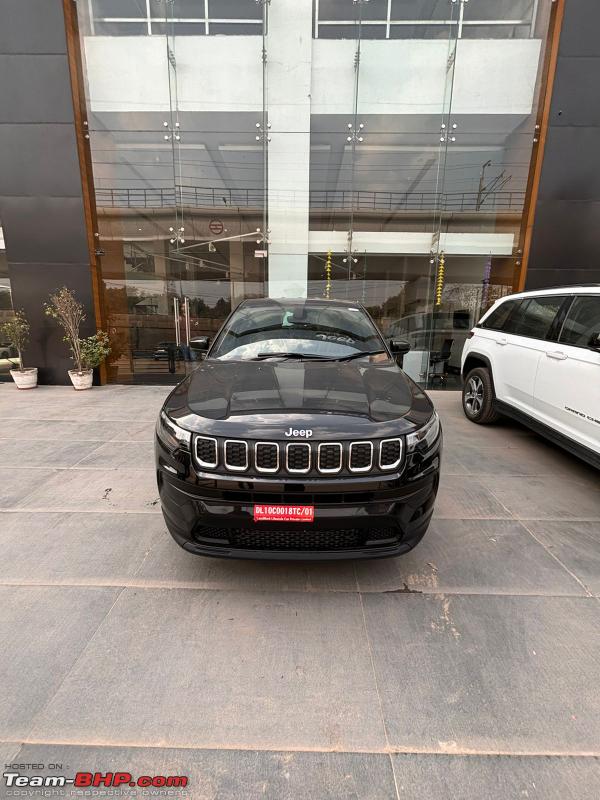
Having already owned a Honda, brands like Maruti and Hyundai were simply ignored (though I have a soft spot for the Creta N). Priya was also firmly against buying something that “every other household in Haryana owns” (she’s a Jaat). This led to Mahindra being rejected outright. Tata was also ruled out due to service issues I’d heard about. This left Jeep next in line in her perceived hierarchy.
My POV:
- Scorpio N was eliminated because the XUV700 seemed like a better option. Besides, the Scorpio N’s suspension didn’t feel great, and its handling was subpar.
- XUV700 could have been our next best choice, but the interior quality felt a bit plasticky, with hardly any soft-touch materials. To top it off, the display vehicle had a few noticeable quality issues.
- Roxx was another contender. Priya was willing to make an exception for this one. It’s a real head-turner with decent reviews. However, by the time we considered it, we had already test-driven the Jeep Compass, and the comparison just didn’t seem fair anymore.
The Jeep Compass Test Drive: Where Our Opinions Merged in Harmony
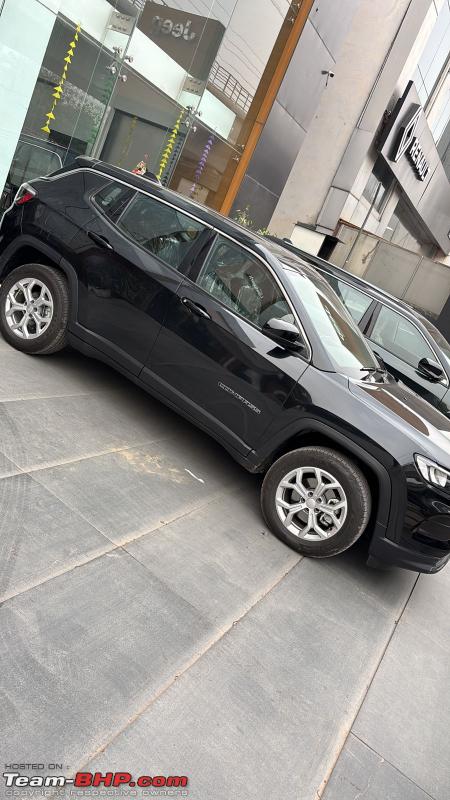
During the Jeep Compass test drive, both Priya and I found ourselves perfectly aligned—a rare marriage of thoughts.
Here’s what stood out during the test drive:
- Great professional staff: They proactively arranged the test drive without us even asking.
- Driving the manual: After using the Amaze CVT and Baleno AMT (now owned by my father after retiring the Amaze Diesel), driving the Compass manual felt like regaining control in life.
- Handling: The steering feedback and precision were miles ahead of anything we’d experienced before.
- The engine: The 2.0 Multijet engine was explosive yet refined.
- Interior quality: Easily the best in its segment.
- Base model essentials: The base model had all the features we truly needed.
- Jeep legacy: Let’s not forget—this is a real Jeep manufacturer, with that legacy in its DNA.
Overall, it was a fantastic experience.
The Deep Dive
After the test drive, I was hooked. I started devouring everything about the Jeep Compass:
- Team-BHP threads (best midsize SUV thread is the best one)
- YouTube reviews
- Ownership threads
- Reddit discussions
- Jeep forums
Except for concerns about reliability, there were no major red flags.
Thoughts on Service Costs and Reliability:
- Service costs: ₹20,000–30,000 per service.
- Service interval: 15,000 km or 1 year (whichever comes first).
- Comparatively, higher running would result in similar expenses with cars like the Harrier or Safari (10,000 km intervals).
- Over 10 years, I estimate spending roughly ₹1.5 lakh extra on service costs. For us, this is manageable, so the “expensive service” argument wasn’t a dealbreaker.
Reliability:
Most issues on forums seemed related to low battery or auxiliary battery problems. With an extended warranty (up to 5 years) and a backup car, this felt like a risk we could handle.
The Final Decision: Jeep Compass

Priya was crystal clear: If it’s Jeep, forget other features. But if we chose anything else, it had to have a sunroof.
Personally, I’m a big fan of base models. I’d always prefer a car from the next segment rather than a higher trim within the same segment.
Here’s where things clicked:
- The XUV700 sunroof model costs almost the same as the Jeep Compass base model.
- For us, the Compass was the obvious choice.
The Deal
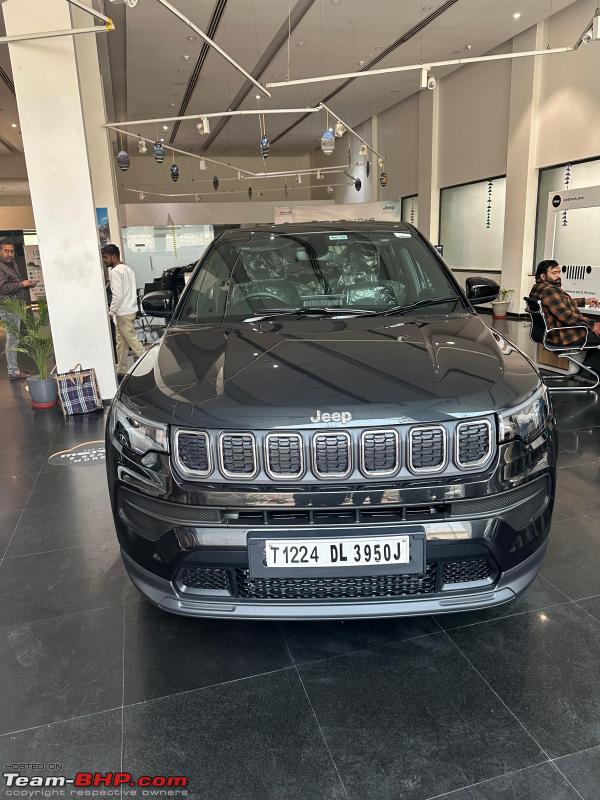
We worked out the deal with Landmark Jeep, South Delhi. There were no discounts on the base model (due to a recent price revision for the Sport variant), but we saved on insurance overheads and logistics.
To further increase the value-for-money quotient, I opted for a BH number, saving an additional couple of lakhs. All in all, it cost us ₹20 lakh. Imran is a great guy to deal with. Give him a try in case you are interested in Compass.
Delivery Experience
- Got free mats, a single ceramic coat, and some cool goodies (the Jeep cap is particularly great).
- The experience was seamless, and the BH number is on its way.
Meet Thunder
Now, let’s talk about the car itself. You’ve read the context, so you’ll connect better now. From this point on, I’ll call it Thunder, because that was the first song we played after bringing it home.
How Does Thunder Look from the Outside?
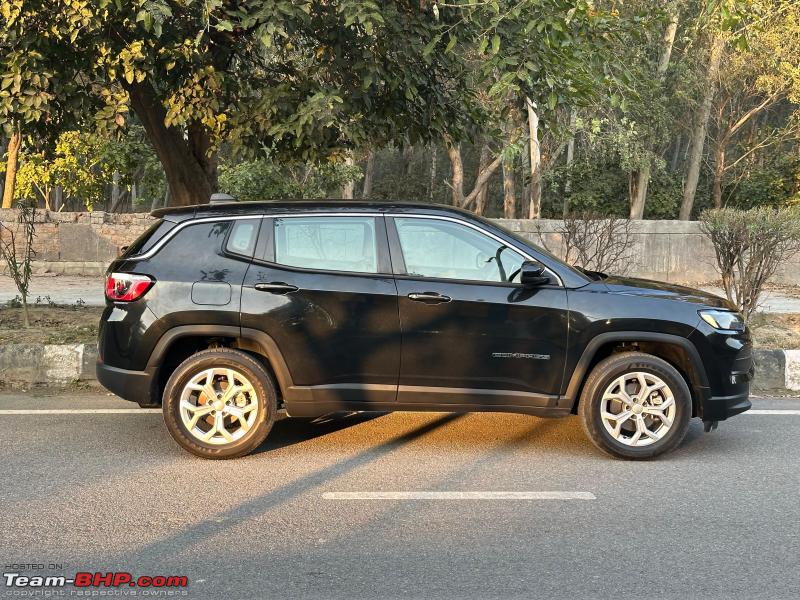
The overall silhouette is excellent—compact yet rugged, thanks to the side plastic cladding. It’s definitely a looker and arguably the best-looking SUV in this segment. Of course, looks are subjective, but most of my friends agree that it excels in the aesthetics department.
The glass blocks UV rays, giving it a premium feel and a slight tint that further enhances its appearance. Once my budget allows, I plan to add roof rails, crossbars, and perhaps paint the alloys black. If aesthetics are a top priority, the Compass should definitely be at the top of your list.
Tires
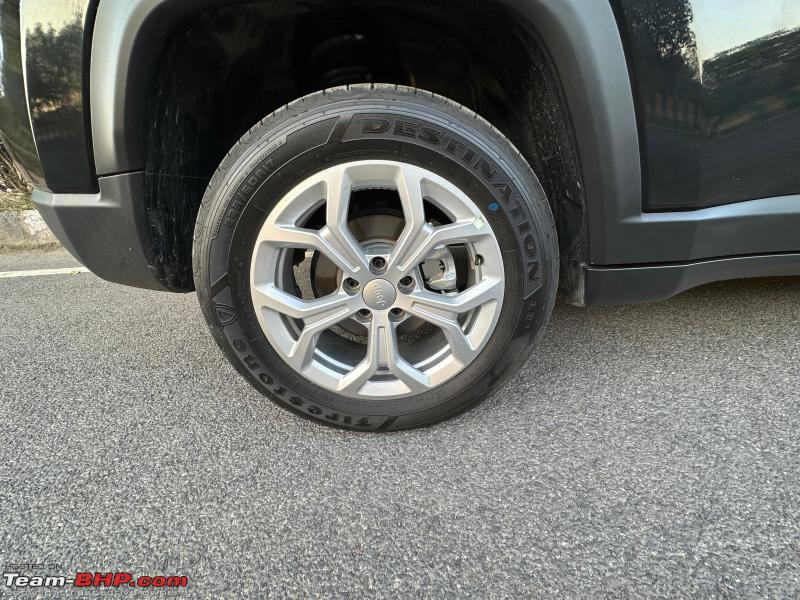
The tires seem to offer good grip in both wet and dry conditions. Road noise is slightly excessive, but for now, they meet my needs.
Engine Bay
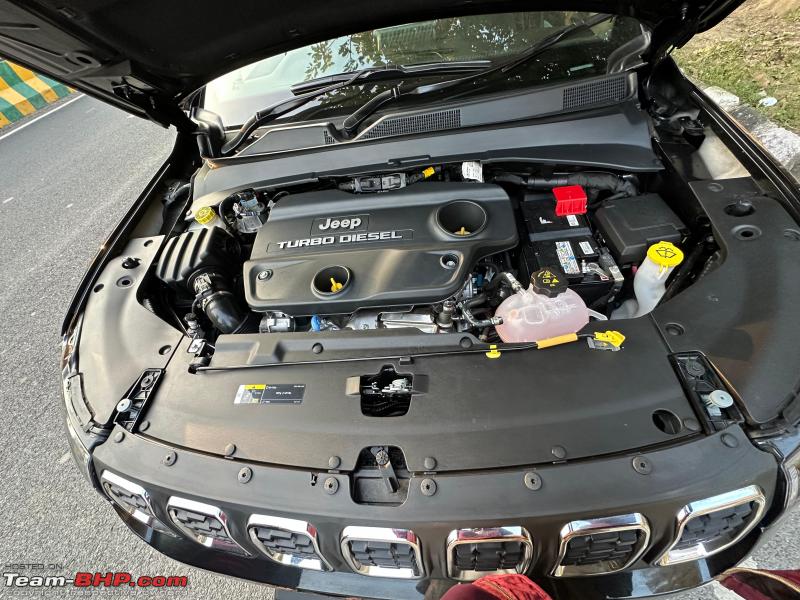
Nothing particularly special here. The engine cover is present, with good protection and insulation on the sides of the hood. It’s a clean bay to look at, and I’m keeping my fingers crossed that this part of the car remains healthy.
Boot
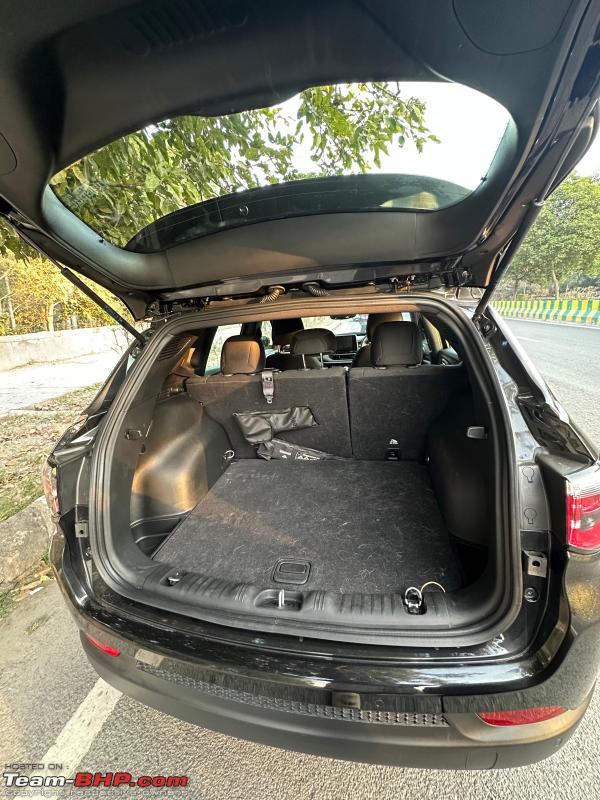
The boot is adequate for four passengers traveling light. It’s not enormous but definitely an upgrade compared to the Honda Amaze. It’s spacious enough—no complaints.
How Does Thunder Look from the Inside?
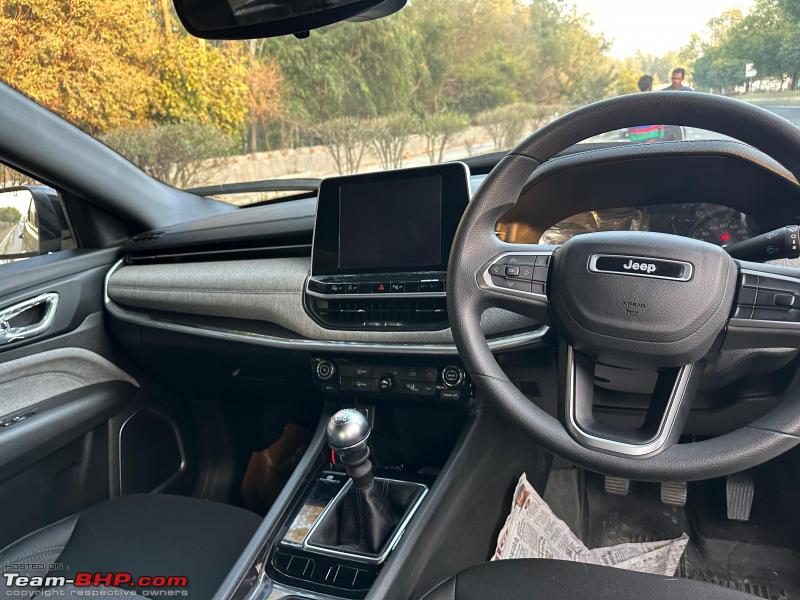
The Sports Base Model features a fabric dashboard material, which looks great when clean. I wish leather interior trim (in black) was available as standard because it looks even better. However, the dealership does offer a complete cabin redo in leather—similar to upper trims—for ₹40,000–₹50,000. We’ll probably opt for that once we tire of the fabric.
Instrument Cluster
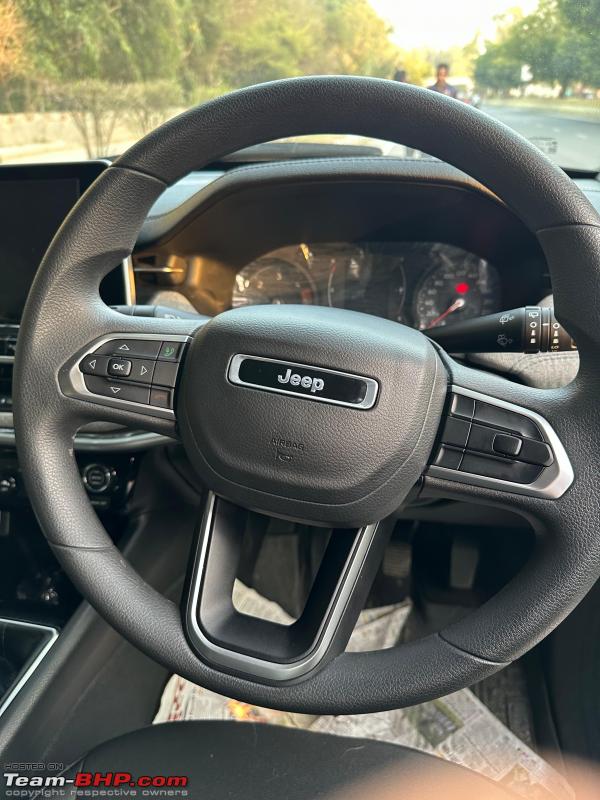
It’s functional and straightforward. While nothing groundbreaking, it offers many controls and doesn’t make me miss digital clusters. The old-school analog dials add a retro touch that I enjoy.
One noteworthy point: when I’ve pushed the tachometer to the redline, there’s no abrupt power cutoff or loss beyond 3,500–4,000 RPM, unlike many other cars.
Functional Controls
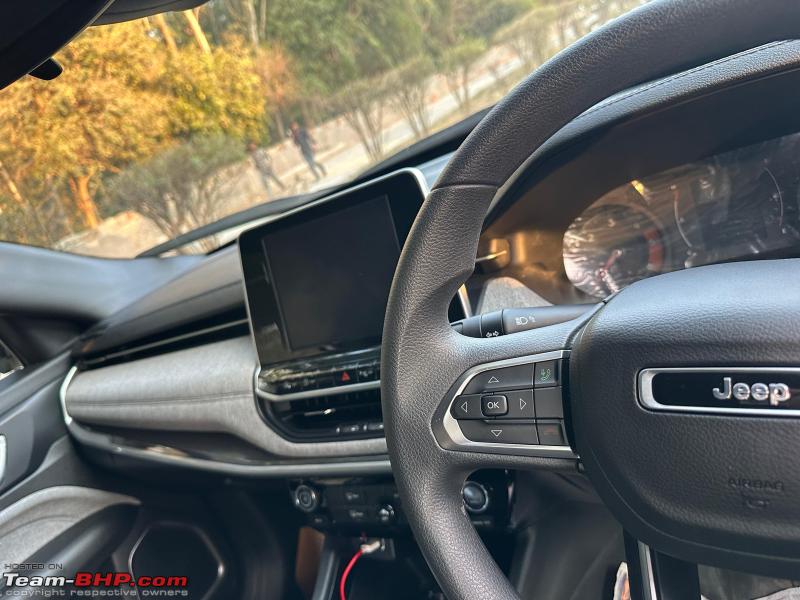
Key features are accessible via buttons, even though most can be operated through the touchscreen. For instance, controls for the volume, FM tuner, AC on/off, fan speed, and circulation mode are just a click away—essential for undistracted driving.
Steering Wheel Controls: Buttons behind the steering wheel are intuitive, as are those on the wheel itself.
Door Buttons: These have a great tactile feel and are backlit, reflecting attention to detail.
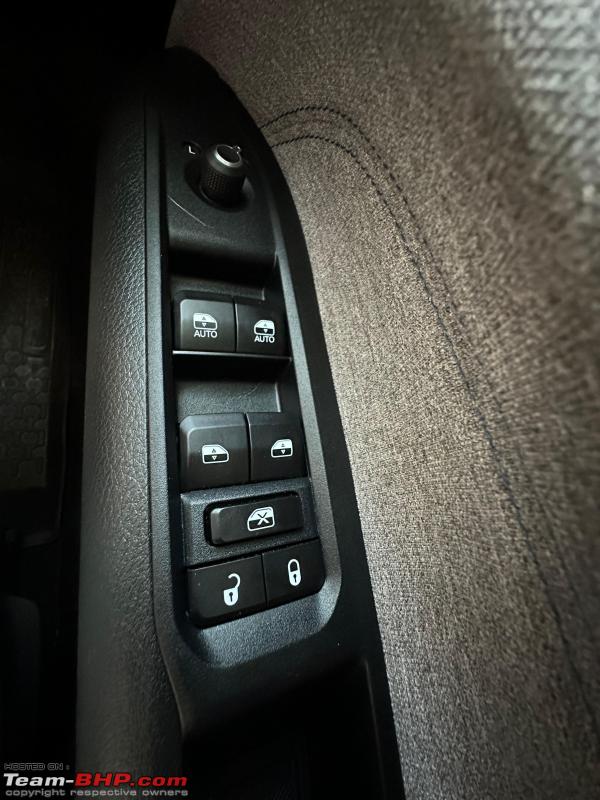

Air Vent Controls: Excellent quality, with no risk of breakage like the vents in the first-gen Amaze.
Comfort
- Front Seats: Offer excellent lumbar and under-thigh support, with good side bolstering.
- Rear Bench Seat: Comfortable for four adults and a child. However, the middle passenger won’t find it as accommodating.
- Armrest: The armrest is padded and at a perfect height, making it easy to rest my arm on the gear knob and the armrest simultaneously. Additionally, the right-hand door armrest aligns with it, enhancing the ergonomic experience—a feature often overlooked in other vehicles.
- Rear Seat: It’s 60/40 foldable and offers great under-thigh support for side passengers, though the middle passenger’s experience is less ideal. The fabric seat material feels premium compared to lower-end cars and even outshines the fabric in lower trims of the Scorpio N.
- Boot Space: Sufficient for luggage for four passengers.
Driver Controls
Steering Wheel:
- Volume and Track Change Controls: Located behind the steering wheel, though one of the buttons feels slightly flimsy.
- Rake and Reach Adjustment: Great to touch and hold.
- Cruise Control: Missing on the manual variant. Interestingly, the base Sport trim in Canada includes cruise control (albeit in the automatic variant).
Gear Knob: A joy to hold, with short and precise throws (except for first gear, which shifts smoothly only at low speeds—common in most manual cars).
Pedals: Perfectly spaced and great to use.
Right and Left Stalks:
- Right Stalk: Wiper controls.
- Left Stalk: Indicators.
Clever Features (Skoda Touch?)
- Electronic Parking Brake with Hill Hold: Standard from the base model. However, explaining its operation to car wash guys can be a task.
- All Four Auto-Down Windows: Possibly a first in this segment.
- Auto-Up Windows with Anti-Pinch (Front Two): Handy and safe.
- Rear Cabin Lights: Turn off with a click—a cool party trick.
- Vanity Mirrors: Both driver and passenger sides. Priya loves this feature!
- Extendable Sun Visors: A nostalgic nod, even the Maruti 800 had these.
- Alloy Wheels (Base Variant): If I owned a white car, I'd paint them black immediately.
- Firestone Tires: Partnered with Bridgestone, they feel reliable.
- Exceptional Insulation: Whether it helps significantly is debatable, but full marks for effort.
- Multi-Layer Rubber Beadings: Soft to touch; however, I’m curious if they’ll need frequent replacements.
- Attention to Detail: Even on parts you can’t see—impressive.
- TPMS (Tire Pressure Monitoring System): From the base model, invaluable for long trips.
- Boot Hooks: Perfect for securing Pookie while folding the rear seat.
- Soft-Close Glovebox Lid: Illuminated for convenience—Priya’s go-to spot for her lipstick.
- Rubber Grips in Cup Holders: A small but thoughtful addition.
- Passenger-Side Lock/Unlock Button: Priya enjoys unlocking doors for rear passengers now.
- Reverse Camera Guidelines: A lifesaver, even with my 70,000 km of driving experience.
- Clever ORVM Design: Appreciated, though not highly impactful.
- Rear Wash and Wipe (with Anti-Fog): Standard from the base model—a practical feature.
- Thick, Heavy Doors and Engine Hood: The solid sheet metal adds to the car’s robust feel.
- No Fuel Tank Cap: The lid is well-sealed, though, so no complaints.
- Compass Display in MID: A nod to the Jeep Compass, adding a nice touch of charm.
- Flush-Fit Floor Mats: Stay perfectly in place, unlike my previous cars’ mats.
- Base Model 4-Speaker System: Surprisingly delivers amazing mids and bass.
- Adjustable Handrest: Aligns perfectly with the gearshift knob, making long drives much more comfortable.
Touch and Feel

- Interior Materials: The interior quality is impressive, with extensive use of soft-touch materials, especially on the dashboard and doors. Few competitors, such as the Harrier or Astor, come close to this level of refinement. Even the XUV700 AX7 doesn’t quite match the premium feel.
- Doors: The doors are heavy and close with a reassuring thud. Even in areas without soft-touch materials, the plastic quality is top-notch.
- Handrest: The padded handrest, fabric upholstery in the base models, and fabric-accented dashboard contribute to a premium experience, making the cabin feel upscale despite being a lower trim.
Headlights
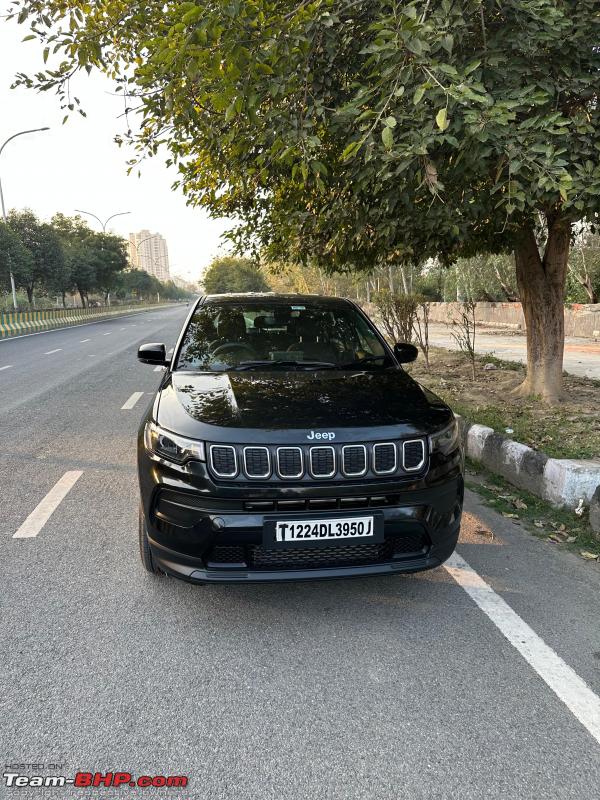
The headlights (both low and high beam) are more than adequate for everyday needs. While higher trims may have a different lighting setup, the current configuration serves its purpose well.
Visibility
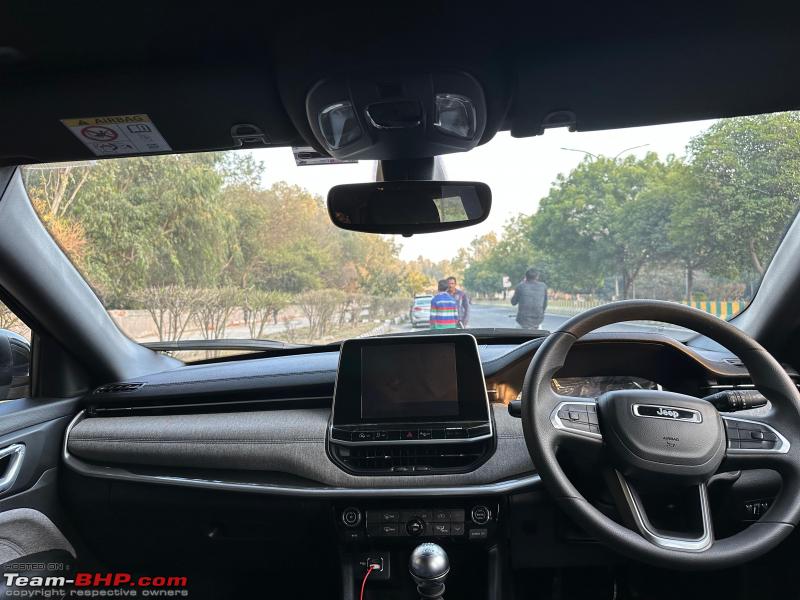
Visibility is excellent overall, though the A-pillars slightly obstruct side views. The compact design of the Compass ensures great drivability, and the reverse camera is of exceptional quality—though its performance at night could be better.
Clutch and Pedal Feel
- Pedal Spacing and Feedback: The pedals are perfectly spaced, with the brake pedal offering good feedback. The accelerator pedal has significant travel, making it easy to maintain a constant speed. There’s a feeling that it’s staged for different speeds—possibly just a placebo, but it works well.
- Clutch Pedal: The clutch strikes a perfect balance—not too heavy, not too light. The engagement point is consistent and easy to identify, with a moderate travel distance. It’s a massive improvement over the Amaze Diesel and Grand i10, offering a refined and predictable feel.
How It Drives?
- Smooth Driving: The driving experience can only be described as "Makhan" (buttery smooth). On city roads or expressways, the clutch and gear shifts work in harmony. In bumper-to-bumper traffic, the clutch release is easy to modulate. Gear shifts—both upshifts and downshifts—are smooth, with no resistance when shifting quickly, except for downshifting to first gear.
- Acceleration: The real magic starts post-1700 RPM, where you feel a distinct push into the seat. Even below this, the car handles well, although 1st gear is essential for speeds below 10 km/h. Above 1700 RPM, the Compass becomes a beast, effortlessly hitting speeds like 120–160 km/h. The throttle response is steady and predictable, making overtaking a breeze.
- Stability at High Speeds: Whether cruising at 120 km/h or higher, the car remains stable. It’s reassuring to have this kind of performance on tap, even if Indian roads rarely allow for it.
Handling
This is the Compass’s standout feature. Every review and ownership report highlights the precise and confident handling, and it’s easy to see why.
- Steering Feedback: The steering is light at low speeds and becomes heavier as speed increases, offering excellent feedback. The return-to-center action is quick, and the adjustability allows for a perfect driving position.
- Overall Feel: The Compass feels planted and agile, with precise control that instills confidence on winding roads and highways alike.
Brakes
- Performance: The braking system is excellent, with all four wheels equipped with disc brakes. The host of safety features ensures reliability in any situation.
- Test Drive Highlight: During the test drive, the salesperson demonstrated the braking prowess by engaging the electronic parking brake at high speed, and the car came to a perfect, straight-line stop.
Suspension and Chassis
- Ride Quality: The suspension is superbly calibrated, absorbing bumps and irregularities effortlessly. There’s no noticeable horizontal or vertical movement, even at higher speeds.
- Dynamic Suspension: This isn’t just a marketing gimmick—it works exceptionally well, providing excellent composure and stability.
- Expressway Stability: The Compass feels like a heavy, planted car on highways, offering unmatched confidence and comfort.
When I mentioned achieving 22+ km/l with the Honda Amaze Petrol CVT, I wasn’t exaggerating. On a smooth run from Noida to Delhi with sparse traffic, I’ve even managed 25+ km/l (cruising at a constant 60 km/h with mild overtaking).
Having mastered a CVT for optimal mileage, transitioning to a manual for fuel efficiency wasn’t a big challenge.
City Mileage
- Enthusiastic Driving: Revving up to 2,000 RPM before shifting in the city results in 12–14 km/l (as shown on the MID, which is mostly accurate with a minor 2–3% variation).
- Moderate Driving: When driven like a typical manual car, 14–15 km/l is easily achievable.
- Economical Driving: Driving it like the Amaze CVT (haven’t tried it much yet), 17–18 km/l seems very achievable.
Highway Mileage
- Cruising at 80–100 km/h: You can expect 20 km/l with ease.
- Cruising at 100–120 km/h: Mileage drops slightly to 18–19 km/l.
Real-World Example
For reference, my Noida-to-Ayodhya round trip (1,500 km) cost just ₹6,800 in fuel. You can do the math!
Conclusion
I’m highly satisfied with the mileage, especially considering this is before the first service. The efficiency only adds to the satisfaction of owning this car.
Final Thoughts
- Great car so far. Am I satisfied? Absolutely.
- Is Priya happy with the purchase? Of course!
- Can Pookie join us on road trips without compromising on space or driver safety? Yes, and comfortably so.
- Has it helped me tackle my midlife crisis? Hell yeahhh!
Now, Let’s Be Real:
- Is it the best car under ₹20–30 lakh? No.
- Is it the best car for people like me? Maybe.
- Is it the best car for the 300-odd customers buying it each month? Certainly seems so.
The Jeep Compass deserves better sales numbers. If you’re in the market, go test-drive the manual variant—it’s an absolute hoot to drive!
Dear Jeep/Stellantis,
Please, market your car to a broader audience if you genuinely intend to increase sales. The Jeep Compass is a fantastic vehicle, but it deserves better recognition.
Here’s my humble request:
- Engage with Current Customers: People like me who’ve experienced the Compass firsthand can vouch for its quality. Talk to us, learn why we chose it, and use that to reach others with similar preferences.
- Understand Your Audience: Dive deeper into the profile of Compass buyers. Who are they? What do they value? Showcase how the Compass aligns perfectly with those aspirations.
- Improve the Automatic Gearbox: The 9-speed automatic is the only real chink in its armor. It’s slow and doesn’t do justice to the otherwise stellar package. The Aisin 6-speed automatic is a tried-and-tested option—please explore integrating it into the Compass lineup.

The Compass deserves more life on the road. It’s a car that can win hearts if more people get to experience it.
Few more pictures-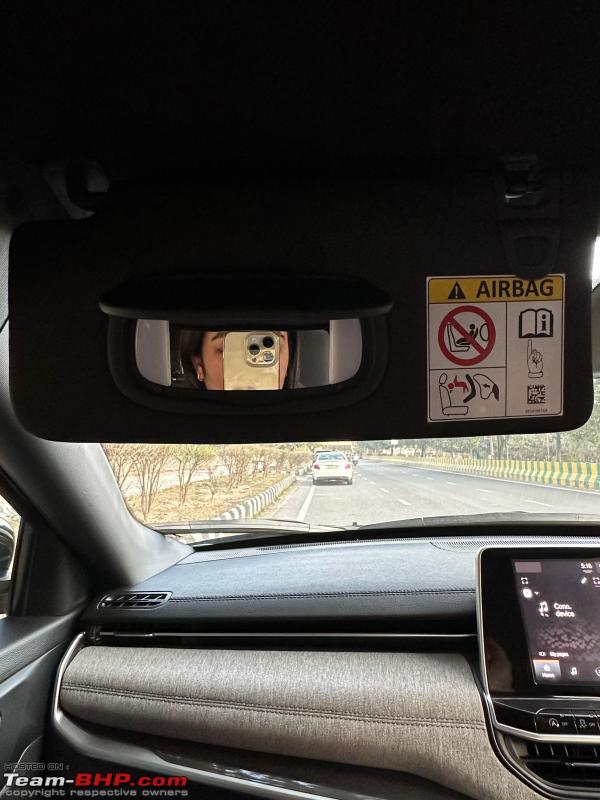
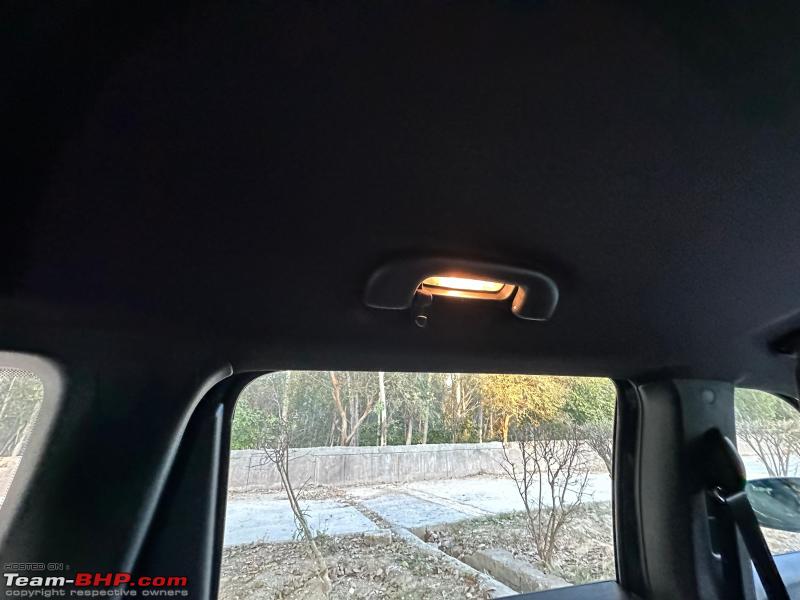
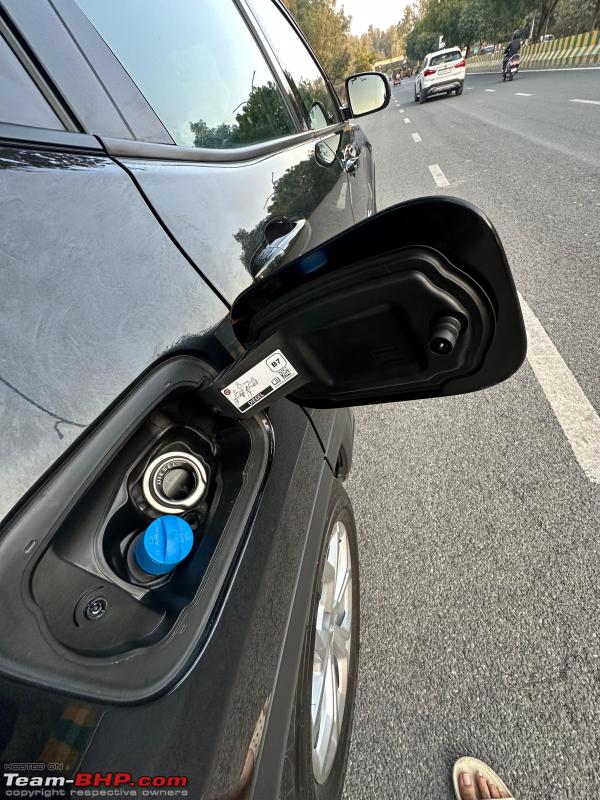
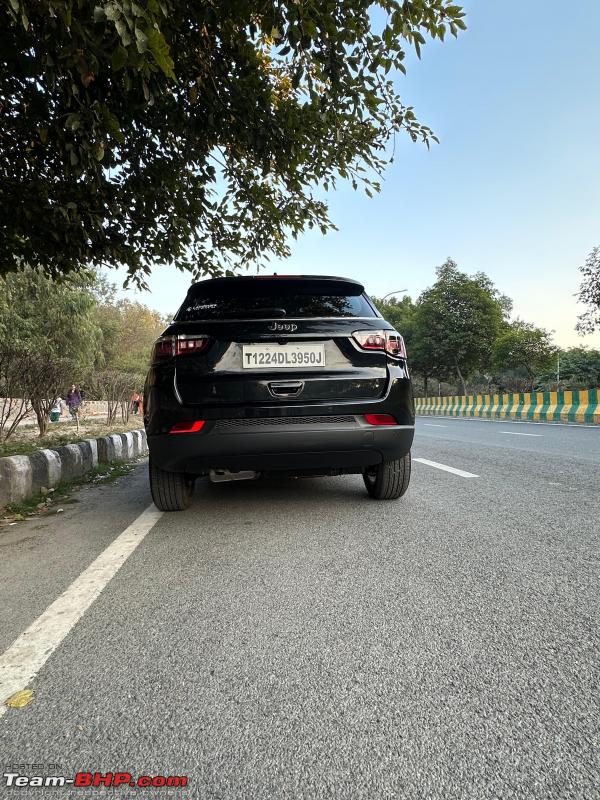
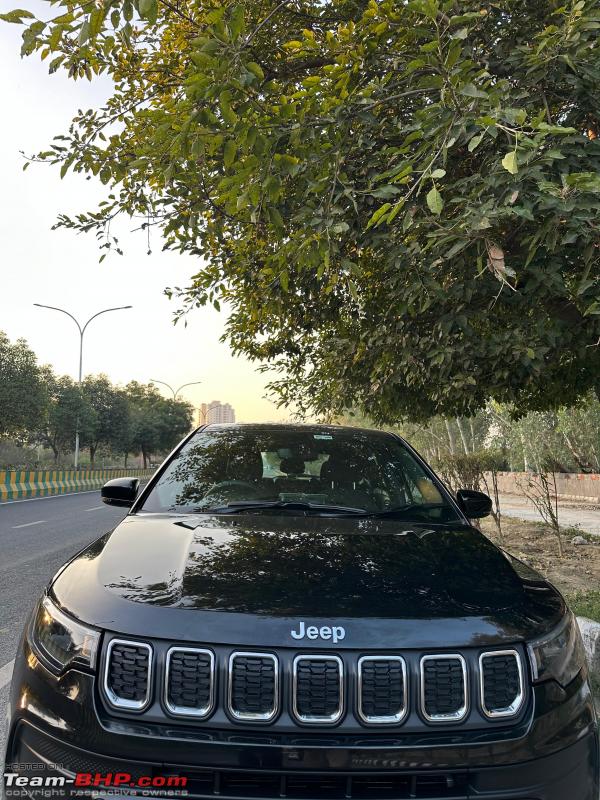
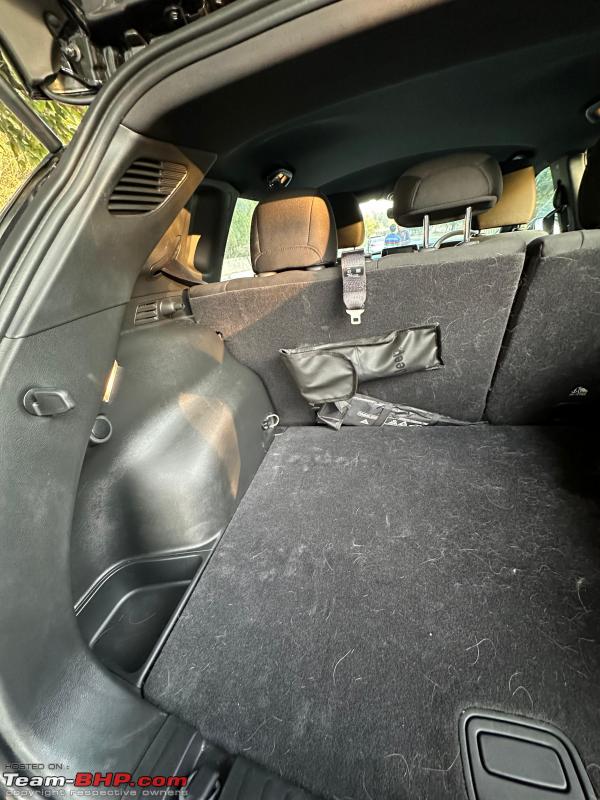
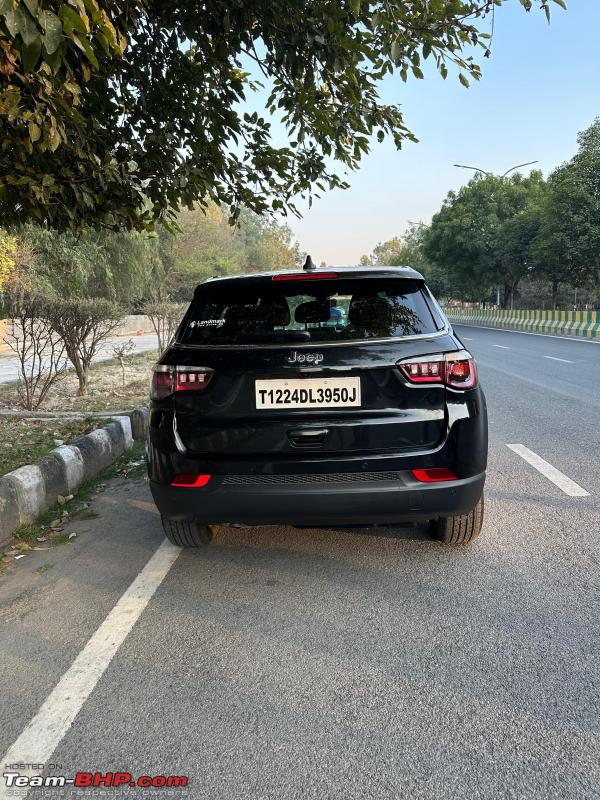
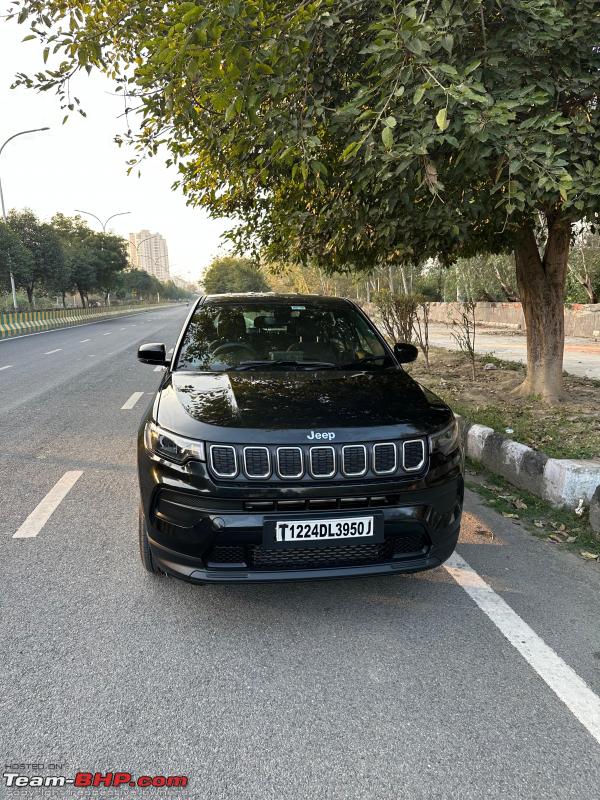
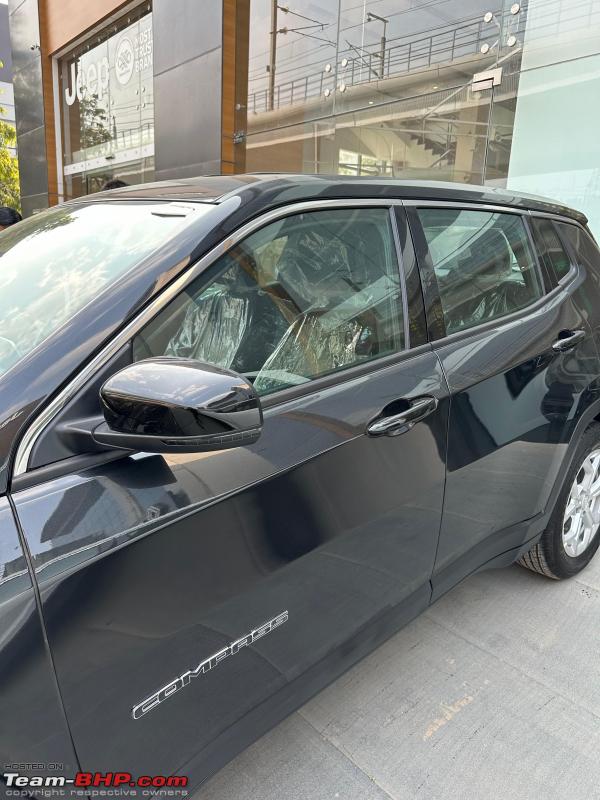
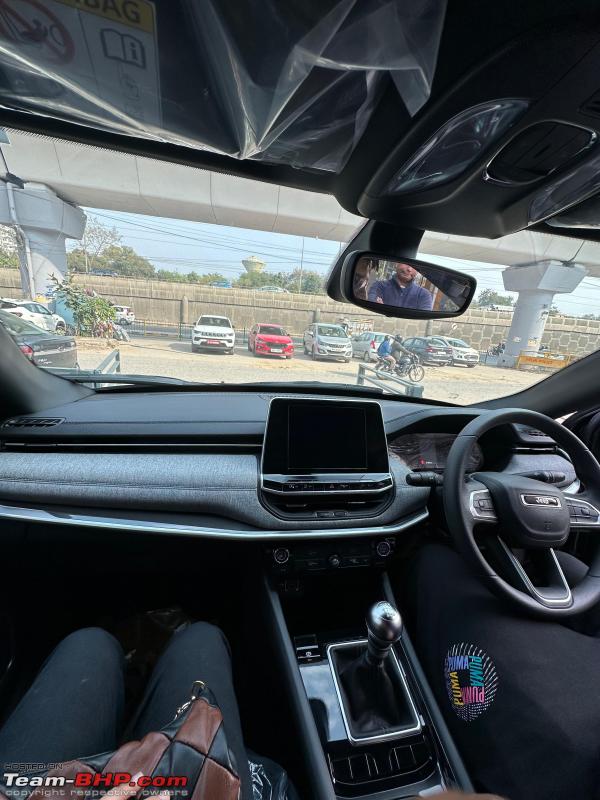
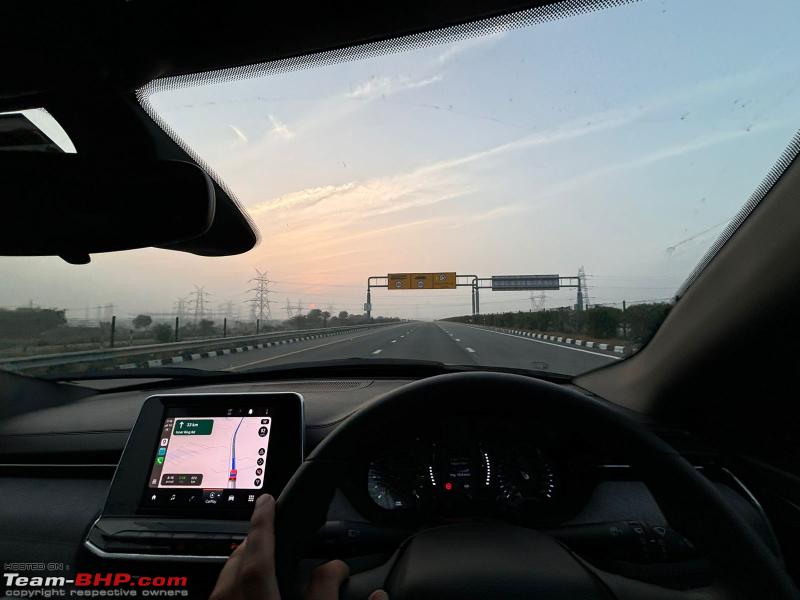
Check out BHPian comments for more insights and information.



